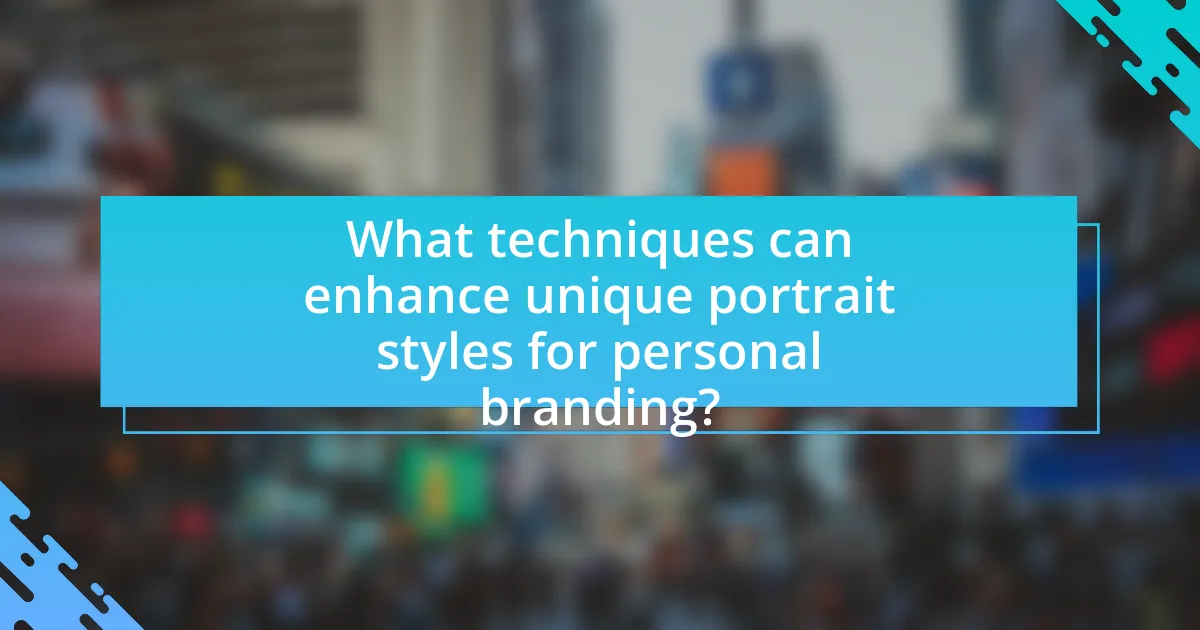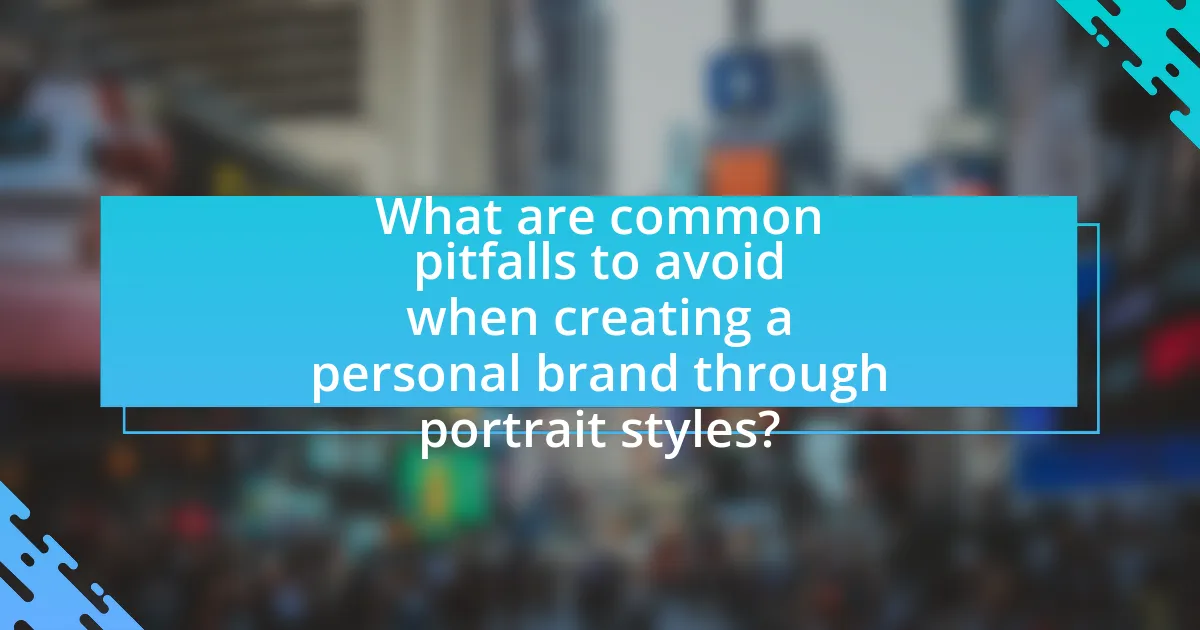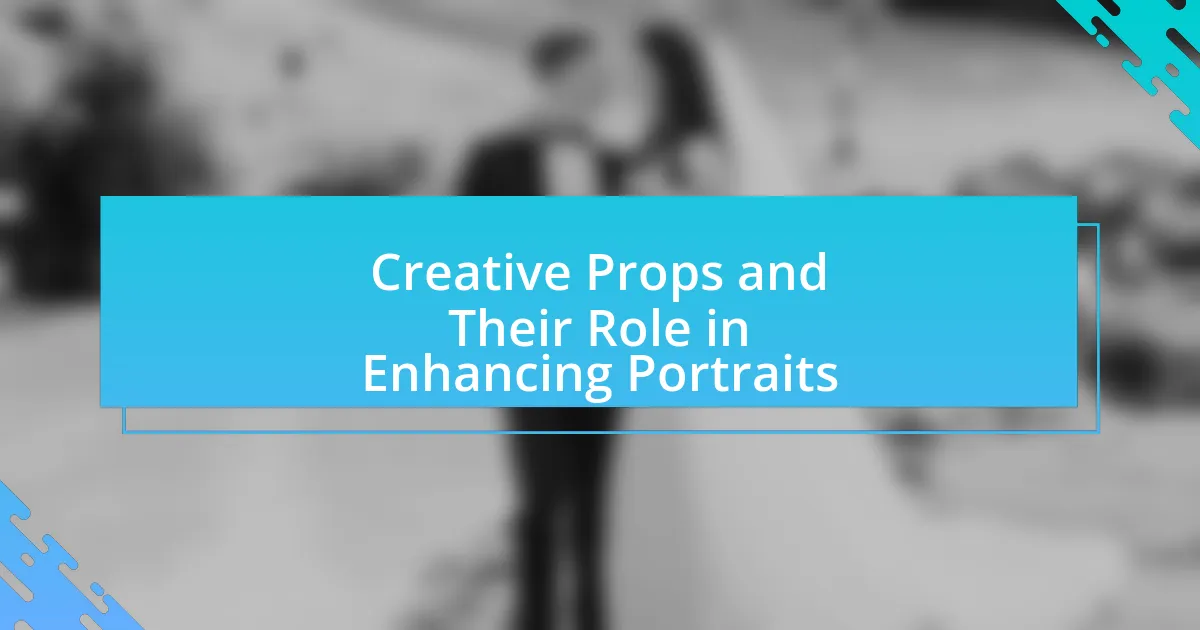Creating a personal brand through unique portrait styles involves utilizing distinctive visual representations to express an individual’s identity, values, and professional persona. This article explores the influence of personal branding on perception, the role of unique portrait styles in differentiating individuals in a competitive market, and how these styles can reflect personality traits. It also discusses the psychological effects of portrait styles on viewers, the importance of authenticity, and best practices for aligning visual elements with personal branding goals. Key techniques for enhancing portrait styles, common pitfalls to avoid, and strategies for effective social media engagement are also examined, providing a comprehensive guide for individuals looking to establish a strong personal brand through tailored imagery.

What is Creating a Personal Brand Through Unique Portrait Styles?
Creating a personal brand through unique portrait styles involves using distinctive visual representations to convey an individual’s identity, values, and professional persona. This approach allows individuals to differentiate themselves in a crowded market by showcasing their personality and expertise through tailored imagery. For instance, a study by the American Psychological Association highlights that visual content significantly influences first impressions, indicating that unique portraits can enhance personal branding effectiveness.
How does personal branding influence perception?
Personal branding significantly influences perception by shaping how individuals are viewed based on their unique attributes and public persona. This influence occurs through consistent messaging, visual identity, and the emotional connections established with an audience. For instance, a study by the Journal of Business Research found that strong personal branding can enhance credibility and trustworthiness, leading to more favorable perceptions among peers and potential clients. This demonstrates that effective personal branding not only communicates an individual’s values and expertise but also directly impacts how they are perceived in professional and social contexts.
What role do unique portrait styles play in personal branding?
Unique portrait styles are essential in personal branding as they visually communicate an individual’s identity and values. These styles differentiate a person in a crowded market, making them memorable and recognizable. For instance, a study by the American Psychological Association highlights that visual elements significantly influence first impressions, which are crucial in branding. By employing distinctive portrait styles, individuals can convey their personality, professionalism, and creativity, thereby enhancing their brand’s authenticity and appeal.
How can portrait styles reflect individual personality traits?
Portrait styles can reflect individual personality traits by visually conveying emotions, preferences, and characteristics through composition, color, and expression. For instance, a vibrant color palette and dynamic poses may indicate an outgoing and energetic personality, while muted tones and formal poses can suggest a more reserved or serious nature. Research in psychology shows that visual elements in portraits, such as facial expressions and body language, significantly influence perceptions of personality traits, supporting the idea that portrait styles serve as a medium for personal expression.
Why is it important to have a unique portrait style?
Having a unique portrait style is crucial for establishing a personal brand because it differentiates an individual from others in a saturated market. A distinctive style creates a recognizable visual identity that resonates with audiences, enhancing memorability and engagement. Research indicates that consistent branding can increase revenue by up to 23%, demonstrating the financial impact of a strong personal brand. Therefore, a unique portrait style not only reflects personal creativity but also serves as a strategic tool for professional success.
What are the psychological effects of unique portrait styles on viewers?
Unique portrait styles can evoke strong emotional responses in viewers, influencing their perceptions and connections to the subject. Research indicates that distinctive artistic choices, such as color, composition, and expression, can enhance viewer engagement and foster a sense of intimacy or familiarity with the portrayed individual. For instance, a study published in the Journal of Personality and Social Psychology found that portraits with unconventional styles can lead to increased viewer interest and empathy, as they challenge normative expectations and invite deeper contemplation of the subject’s identity. This psychological impact underscores the importance of unique portrait styles in shaping personal branding, as they can effectively communicate individuality and resonate with audiences on an emotional level.
How does uniqueness in portrait styles differentiate individuals in a crowded market?
Uniqueness in portrait styles differentiates individuals in a crowded market by establishing a distinct visual identity that resonates with their target audience. This differentiation is crucial as it allows individuals to stand out among competitors, fostering recognition and recall. For instance, a study by the American Psychological Association indicates that unique visual elements can enhance brand memorability by up to 80%. By employing distinctive color palettes, composition techniques, or thematic elements, individuals can create a signature style that not only reflects their personality but also appeals to specific demographics, thereby increasing engagement and connection with potential clients.
What are the key elements of a personal brand?
The key elements of a personal brand include authenticity, consistency, visibility, and value proposition. Authenticity ensures that the personal brand reflects the true self of the individual, which fosters trust and connection with the audience. Consistency across various platforms and communications reinforces the brand identity, making it recognizable and reliable. Visibility is crucial for reaching the target audience, achieved through strategic marketing and engagement efforts. Lastly, a clear value proposition articulates what the individual offers that differentiates them from others, providing a compelling reason for others to engage with their brand. These elements collectively contribute to a strong and effective personal brand.
How do visual elements contribute to personal branding?
Visual elements significantly enhance personal branding by creating a recognizable and memorable identity. These elements, such as color schemes, typography, and imagery, help convey an individual’s values, personality, and professional image. For instance, a consistent color palette can evoke specific emotions and associations, making the brand more relatable and appealing to the target audience. Research indicates that color increases brand recognition by up to 80%, demonstrating the power of visual elements in establishing a strong personal brand.
What messaging should accompany unique portrait styles?
Messaging that should accompany unique portrait styles includes emphasizing individuality, authenticity, and the emotional connection that the portraits evoke. Highlighting how each portrait reflects the subject’s personality and story fosters a deeper engagement with the audience. For instance, stating that “this portrait captures the essence of your unique journey” reinforces the personal brand’s narrative. Additionally, using phrases like “celebrate your individuality” or “express your true self” can resonate with potential clients, as they seek portraits that not only represent them visually but also convey their personal stories. This approach aligns with the growing trend of personalized branding, where consumers increasingly value authenticity and connection in visual representations.
How can one effectively create a personal brand through portrait styles?
To effectively create a personal brand through portrait styles, one should select a consistent visual theme that reflects their personality and values. This involves choosing specific colors, backgrounds, and poses that resonate with the intended audience and convey a clear message about the individual’s identity. For instance, a professional in the creative industry might opt for vibrant colors and dynamic poses to showcase innovation, while someone in a corporate field may choose more subdued tones and formal poses to project professionalism. Research indicates that visual consistency in branding can increase recognition by up to 80%, highlighting the importance of a cohesive portrait style in establishing a strong personal brand.
What steps should be taken to identify a unique portrait style?
To identify a unique portrait style, an individual should first analyze their personal interests and influences in photography. This involves reflecting on the types of portraits that resonate with them, such as lighting, composition, and subject matter. Next, they should experiment with various techniques and settings to discover what feels authentic and visually appealing. Documenting this experimentation process helps in recognizing patterns and preferences that emerge over time. Additionally, seeking feedback from peers or mentors can provide valuable insights into the distinctiveness of their style. Researching successful portrait photographers and their approaches can also inspire and inform one’s unique style development.
How can individuals align their portrait styles with their personal brand message?
Individuals can align their portrait styles with their personal brand message by consciously selecting visual elements that reflect their values, personality, and professional identity. For instance, a corporate professional may choose a formal attire and a neutral background to convey authority and reliability, while a creative entrepreneur might opt for vibrant colors and an artistic setting to express innovation and approachability. Research indicates that visual consistency across personal branding elements enhances recognition and trust; a study by the Journal of Marketing Research found that cohesive branding can increase consumer trust by up to 30%. Therefore, aligning portrait styles with personal brand messages involves intentional choices in attire, setting, and overall presentation that resonate with the intended audience and reinforce the desired brand identity.

What techniques can enhance unique portrait styles for personal branding?
Techniques that can enhance unique portrait styles for personal branding include utilizing distinctive lighting, incorporating personal props, and experimenting with various angles and compositions. Distinctive lighting, such as backlighting or dramatic shadows, can create mood and emphasize personality traits, making the portrait more memorable. Incorporating personal props that reflect individual interests or professions adds a layer of storytelling, allowing viewers to connect with the subject on a deeper level. Experimenting with angles and compositions, such as close-ups or unconventional framing, can highlight unique features and create a visually striking image that stands out in a crowded digital landscape. These techniques collectively contribute to a strong personal brand by ensuring that portraits are not only visually appealing but also authentically represent the individual.
How can lighting and composition affect portrait styles?
Lighting and composition significantly influence portrait styles by shaping the mood, focus, and overall aesthetic of the image. Proper lighting can create depth and dimension, highlighting facial features or casting shadows that evoke emotion; for instance, soft, diffused light often results in a flattering and gentle appearance, while harsh lighting can create dramatic effects. Composition, which involves the arrangement of elements within the frame, directs the viewer’s attention and can convey different narratives; techniques such as the rule of thirds or leading lines can enhance the visual impact of a portrait. Studies in photography emphasize that these elements are crucial in defining a subject’s personality and brand identity, as they can either reinforce or contradict the intended message of the portrait.
What are the best practices for using natural light in portraits?
The best practices for using natural light in portraits include shooting during the golden hour, utilizing diffused light, and positioning subjects strategically. Shooting during the golden hour, which occurs shortly after sunrise or before sunset, provides soft, warm light that enhances skin tones and reduces harsh shadows. Utilizing diffused light, such as that found in shaded areas or on overcast days, minimizes glare and creates a more even illumination on the subject’s face. Positioning subjects with their backs to the light source can create a beautiful rim light effect, adding depth and dimension to the portrait. These practices are supported by photography experts who emphasize the importance of light quality in achieving flattering and visually appealing portraits.
How does composition influence the storytelling aspect of a portrait?
Composition significantly influences the storytelling aspect of a portrait by determining how elements within the frame interact to convey emotion and narrative. The arrangement of subjects, use of space, and choice of angles can highlight specific traits or themes, guiding the viewer’s interpretation. For instance, a close-up shot can evoke intimacy, while a wider shot may suggest isolation or context. Research by the American Psychological Association indicates that visual composition affects emotional responses, reinforcing the idea that strategic placement of elements can enhance the narrative conveyed through a portrait.
What role does wardrobe selection play in portrait styles?
Wardrobe selection plays a crucial role in defining portrait styles by influencing the subject’s visual identity and emotional expression. The choice of clothing can convey personality traits, social status, and cultural background, thereby shaping the viewer’s perception. For instance, studies show that colors and patterns in clothing can evoke specific emotions; for example, blue often conveys calmness, while red can signify passion. Additionally, well-chosen attire can enhance the overall composition of the portrait, drawing attention to the subject and creating a cohesive aesthetic that aligns with the intended personal brand.
How can clothing choices reflect personal branding goals?
Clothing choices can reflect personal branding goals by visually communicating an individual’s values, personality, and professional identity. For instance, a professional in the tech industry may opt for smart-casual attire to convey innovation and approachability, while a corporate executive might choose tailored suits to project authority and professionalism. Research indicates that first impressions are formed within seconds, and attire plays a crucial role in this perception, influencing how others interpret one’s competence and credibility. According to a study published in the Journal of Experimental Social Psychology, clothing can significantly affect the way individuals are perceived in terms of status and professionalism, reinforcing the idea that strategic clothing choices can effectively align with and enhance personal branding objectives.
What colors and styles are most effective for conveying specific messages?
Colors and styles significantly influence the perception of messages in personal branding. For instance, blue conveys trust and professionalism, making it effective for corporate branding, while red evokes passion and urgency, suitable for creative industries. Additionally, minimalist styles communicate clarity and sophistication, appealing to modern audiences, whereas bold, vibrant styles can express creativity and energy, attracting attention in competitive markets. Research indicates that 85% of consumers make purchasing decisions based on color, highlighting the importance of color choice in branding strategies.
How can post-processing techniques enhance portrait styles?
Post-processing techniques can significantly enhance portrait styles by refining image quality and emphasizing key features. Techniques such as skin retouching, color grading, and background blurring improve the overall aesthetic, making portraits more visually appealing. For instance, skin retouching can remove blemishes and enhance texture, while color grading can create a specific mood or atmosphere that aligns with a personal brand. Additionally, background blurring, achieved through selective focus, draws attention to the subject, enhancing their presence in the image. These enhancements not only elevate the artistic quality of portraits but also help in establishing a distinctive personal brand identity.
What editing tools are recommended for personal branding portraits?
Adobe Lightroom and Adobe Photoshop are recommended editing tools for personal branding portraits. Adobe Lightroom excels in photo organization and batch editing, allowing users to enhance images with presets and adjustments efficiently. Adobe Photoshop offers advanced retouching capabilities, enabling detailed edits such as skin smoothing, background removal, and creative compositing. Both tools are industry standards, widely used by professional photographers, which validates their effectiveness in creating polished and impactful personal branding portraits.
How can filters and effects be used to maintain authenticity?
Filters and effects can be used to maintain authenticity by enhancing the natural qualities of an image without altering its core essence. For instance, subtle adjustments in brightness, contrast, and color saturation can highlight a subject’s features while preserving their true appearance. Research indicates that authenticity in visual content fosters trust and engagement; a study by the University of Southern California found that images perceived as authentic lead to higher viewer retention and emotional connection. Therefore, when filters and effects are applied thoughtfully, they can enhance the storytelling aspect of a portrait while keeping the subject’s genuine characteristics intact.

What are common pitfalls to avoid when creating a personal brand through portrait styles?
Common pitfalls to avoid when creating a personal brand through portrait styles include inconsistency in visual elements, neglecting target audience preferences, and failing to convey authenticity. Inconsistency can confuse viewers and dilute brand identity; for instance, using varying color schemes or styles across portraits can lead to a lack of recognition. Neglecting the preferences of the target audience may result in portraits that do not resonate, ultimately failing to engage potential followers or clients. Lastly, failing to convey authenticity can make a brand appear disingenuous; research shows that 86% of consumers value authenticity in brands, highlighting the importance of genuine representation in portrait styles.
What mistakes do individuals often make in their portrait styles?
Individuals often make the mistake of neglecting proper lighting in their portrait styles. Poor lighting can lead to unflattering shadows and highlights, diminishing the overall quality of the image. Additionally, many individuals fail to consider their background, which can distract from the subject and detract from the intended message of the portrait. Another common error is not paying attention to composition, such as framing and angles, which can result in awkward or unbalanced images. Lastly, individuals frequently overlook the importance of expressing genuine emotion, leading to stiff and lifeless portraits that do not resonate with viewers. These mistakes can significantly impact the effectiveness of a portrait in conveying a personal brand.
How can over-editing detract from personal branding efforts?
Over-editing can detract from personal branding efforts by creating an inauthentic representation of an individual. When images are excessively altered, they may mislead audiences about a person’s true appearance and character, leading to a disconnect between the brand and the individual. This misalignment can result in a loss of trust, as consumers often value authenticity; a study by Stackla found that 86% of consumers say that authenticity is important when deciding what brands they like and support. Therefore, over-editing undermines the credibility of personal branding by prioritizing aesthetics over genuine representation.
What are the risks of following trends instead of personal authenticity?
Following trends instead of personal authenticity can lead to a lack of genuine connection with an audience, resulting in diminished trust and engagement. When individuals prioritize trends, they may compromise their unique identity, making it difficult to stand out in a saturated market. Research indicates that brands perceived as authentic are 12 times more likely to be trusted by consumers, highlighting the importance of authenticity in building relationships. Additionally, trends can be fleeting; relying on them may result in a brand that quickly becomes outdated, while authenticity fosters long-term loyalty and recognition.
How can feedback improve portrait styles for personal branding?
Feedback can significantly enhance portrait styles for personal branding by providing insights into how images are perceived by the target audience. This process allows individuals to identify which elements of their portraits resonate well and which do not, leading to more effective visual representation. For instance, studies show that portraits that align closely with audience expectations can increase engagement by up to 50%. By incorporating constructive criticism regarding aspects such as lighting, composition, and expression, individuals can refine their portraits to better reflect their personal brand identity and values.
What methods can be used to gather constructive feedback on portraits?
To gather constructive feedback on portraits, artists can utilize methods such as peer reviews, online surveys, and social media engagement. Peer reviews involve sharing portraits with fellow artists or mentors who can provide specific critiques based on their expertise. Online surveys can be distributed to a broader audience, allowing viewers to rate aspects like composition, color, and emotional impact, which can yield quantitative data for analysis. Social media platforms enable artists to post their work and solicit feedback directly from followers, fostering an interactive dialogue that can highlight strengths and areas for improvement. These methods are effective as they leverage diverse perspectives, enhancing the artist’s understanding of how their work is perceived.
How can one implement feedback while staying true to their brand?
To implement feedback while staying true to a brand, one should align the feedback with the brand’s core values and mission. This involves evaluating the feedback to determine if it enhances the brand’s identity or message. For instance, if a personal brand focuses on authenticity and creativity, feedback suggesting overly commercialized approaches should be critically assessed and potentially disregarded. Research indicates that brands that maintain consistency with their core values are more likely to foster customer loyalty, as seen in studies by the Harvard Business Review, which highlight that 64% of consumers cite shared values as the primary reason for a strong brand relationship. Therefore, integrating feedback that resonates with the brand’s essence while filtering out misaligned suggestions ensures authenticity is preserved.
What are the best practices for showcasing unique portrait styles?
The best practices for showcasing unique portrait styles include utilizing diverse lighting techniques, experimenting with composition, and incorporating personal elements that reflect the subject’s personality. Diverse lighting can enhance mood and depth, while unique compositions can draw attention and create visual interest. Incorporating personal elements, such as clothing or props that resonate with the subject, adds authenticity and connection. These practices are supported by studies indicating that personalized and well-composed portraits significantly increase viewer engagement and emotional response, thereby strengthening personal branding.
How can social media platforms be utilized effectively for personal branding?
Social media platforms can be utilized effectively for personal branding by consistently sharing high-quality, authentic content that reflects one’s unique identity and expertise. Engaging with followers through comments and direct messages fosters community and builds trust, while utilizing platform-specific features like stories, reels, or live sessions enhances visibility. According to a 2021 survey by Sprout Social, 70% of consumers feel more connected to brands that engage with them on social media, highlighting the importance of interaction in personal branding. Additionally, using analytics tools to track engagement metrics allows individuals to refine their strategies based on audience preferences, ensuring that their personal brand resonates effectively.
What strategies can enhance visibility and engagement with portrait styles?
To enhance visibility and engagement with portrait styles, utilizing social media platforms effectively is crucial. Social media channels like Instagram and Pinterest are visually driven, making them ideal for showcasing portrait styles. Engaging with followers through regular posts, stories, and live sessions can significantly increase interaction. Additionally, using relevant hashtags and collaborating with influencers can broaden reach and attract a larger audience. According to a study by HubSpot, posts with images receive 94% more views than those without, highlighting the importance of visual content in engagement strategies.
What practical tips can help in creating a personal brand through unique portrait styles?
To create a personal brand through unique portrait styles, focus on defining your visual identity by selecting a consistent theme, color palette, and style that reflects your personality and values. This approach ensures that your portraits resonate with your target audience and convey a clear message about who you are. For instance, using specific colors can evoke emotions; blue often represents trust, while red signifies passion. Additionally, consider the context of your portraits—whether they are taken in a professional setting or a more casual environment—as this can influence how your brand is perceived. Research shows that visual consistency across platforms can increase brand recognition by up to 80%, highlighting the importance of a cohesive portrait style in personal branding.

















